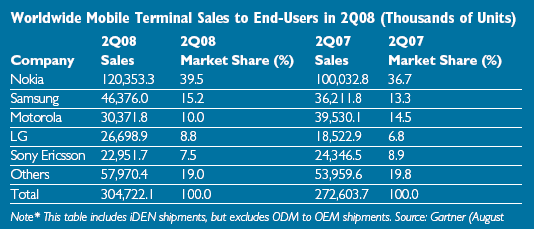
 |
It is a tougher market out there right now for handset sales, but it is definitely not doom and gloom. Worldwide sales of mobile phones reached close to 305 million units in the second quarter of 2008, an 11.8% increase over the second quarter of 2007, according to Gartner Research, a technology advisory company.
Sales of mobile phones in the mature markets of Western Europe and North America slightly recovered after a difficult start to 2008, with Western Europe reaching close to 42 million units while North America surpassed 44 million units in the second quarter of 2008, Gartner says.
Carolina Milanesi, research director for mobile devices at Gartner, based in Egham, UK, comments on the market in the second quarter this year: “The economic environment continued to negatively impact mobile phones sales in both mature and emerging markets. Consumers in mature markets continued to favour mid tier devices over high end devices, while new subscribers continued to join mobile networks in emerging markets during the quarter. However, replacement sales remained weak, as consumers faced higher prices for fuel and food in addition to higher levels of inflation. Despite this, we remain positive that mobile phone sales in 2008 will reach 1.28 billion units.”
Operators fight to top the polls
In terms of overall sales, Gartner says Japanese vendors such as Sharp, Panasonic and Kyocera have historically been the closest to the top five vendors in the worldwide rankings. However, in the past couple of years the Japanese market has become more saturated and Japanese vendors’ attempts to break into other markets have failed. This has weakened their role in the worldwide market. Players such as Research In Motion, Tianyu Technology and Gionee Communication of China have subsequently been filling the void, according to the research.
Nokia sold 120.4 million mobile phones in the second quarter of 2008 and widened its lead to control 39.5% of the global mobile phones market. Sales in the ultra low cost segment remained strong thanks to Nokia’s distribution strategy, economies of scale and brand power.
However, competition is increasing in this segment and at the high end. In July, Nokia applied strategic price cuts in its mid tier portfolio, which put pressure on competitors such as Sony Ericsson and LG. Gartner expects Nokia to increase its market share in the second half of 2008 thanks to its wide portfolio, but also its long awaited touch screen device will be a high-mid tier one, rather than the expected high tier, device. This will help drive sales, assuming it has the right look, specification and usability.
Samsung’s mobile phones sales into the channel reached 45.7 million units. Good inventory management, however pushed sales up and helped Samsung reach a market share of 15.2% in the second quarter of 2008. Samsung’s strong performance this quarter helped widen its lead over third-placed Motorola. “We expect Samsung’s sales to remain strong in the second half of 2008 as new products such as the Omnia pick up momentum,” said Milanesi.
With mobile phone sales reaching 30.4 million units, Motorola’s worldwide market share dropped further in the second quarter of 2008 at -4.5% year on year. Nevertheless, sales grew quarter on quarter and reached 30.4 million units. Motorola’s portfolio remained uncompetitive because of its lack of 3G and hot applications such as GPS and good quality internet browsing. Gartner remains sceptical that the revamp of products such as the Ming in response to the touch screen frenzy seen in the market is a strategy that will help boost sales. Motorola runs the risk of having to lower the prices of its handsets to compete because of a lack of features.
LG’s positive momentum continued in the second quarter of 2008, with mobile phone sales amounting to 26.7 million units. This represented a 2% increase year on year. LG has been focusing on strengthening its portfolio and improving profitability, and its efforts have clearly paid off. Gartner expects LG to sell most of the inventory built up in the second quarter during the third quarter of 2008 and make up for expected weaker sales into the channel.
Sony Ericsson’s market share grew slightly in the second quarter of 2008 sequentially with worldwide mobile phone sales reaching close to 23 million units. However, annual market share fell by 1.4%, preventing the vendor from advancing from its number five position in the worldwide mobile handset market.
“Our confidence in an improved performance by Sony Ericsson weakened further as recent product announcements were disappointing since they delivered similar current features and designs,” said Milanesi. She said Sony Ericsson has gone from eyeing the number three position in the worldwide ranking to fighting to regain the No. 4 spot in just a few quarters. According to Gartner, Sony Ericsson needs new designs and a wider feature and application offering to remain competitive.
Region by region shake down
In the second quarter of 2008, 115 million mobile handsets were sold in Asia-Pacific. This represented a 20.5% increase over the second quarter of 2007.
Anshul Gupta, principal research analyst for mobile terminals at Gartner, based in Mumbai, India, comments: “Net new cellular connections declined significantly. Operators added more than 83 million connections in the first quarter of 2008, but they added only 75 million in the second quarter of 2008. This drop negatively impacted sales of mobile devices in the second quarter of 2008. In addition, high food prices and inflation also had a negative impact on sales of replacement mobile handsets.” Sales in emerging markets bolstered the overall growth in the region as the growth in mature markets remained flat, he added.
Sales in the Eastern Europe, the Middle East and Africa region reached 56 million units, which represented an 18% increase year on year. Annette Zimmermann, senior research analyst for mobile devices at Gartner, based in Munich, Germany, states: “The economy in several countries has slowed down and the region saw slower than expected replacement sales as consumers dealt with the higher cost of living. Despite these unfavourable conditions, operators and handset vendors continue to target areas with low penetration in the Commonwealth of Independent States and West Africa.”
In Japan, sales to end users totalled 9.4 million units in the second quarter of 2008, a decrease of 22.1% year on year. Commenting, Kenshi Tazaki, managing vice president, mobile communications research, Gartner, based in Tokyo, Japan, says: “This drop is twice as much as last quarter and it was the result of a lack of new phone features that were compelling enough to drive growth.” In addition, pricing schemes introduced at the end of 2007 that reduced subsidy levels have further weakened users’ impetus to replace their mobile devices.
Sales of mobile handsets in Latin America surpassed 38.5 million units in the second quarter of 2008, representing an increase of almost 19% from the same quarter last year. Tuong Nguyen, analyst for mobile terminals at Gartner, based in Arlington, Virginia, USA, adds: “The performance this quarter was below expectations mainly due to strong growth in the first quarter of 2008 and slightly weaker demand in the second quarter of 2008, generating higher levels of inventory as vendors did not fully materialise sales.”
In North America, sales to end users totalled 44.1 million units in the second quarter of 2008, a 6.58% increase from the second quarter of 2007. Hughes De La Vergne, principal analyst for mobile terminals research at Gartner, based in Dallas, Texas, USA, states: “Despite industry concerns over the economic downturn, handset sales were strong, up 5.3 quarter on quarter. New subscribers were limited during the quarter, as growth continued to be dominated by replacement sales.”
Western Europe pushes growth
The market in Western Europe picked up slightly in the second quarter of 2008 when sales of mobile handsets reached close to 42 million units, a decrease of 8.2% from the second quarter of 2007.
Milanesi continues: “However, the market was up 16% quarter on quarter. The region reached a penetration rate of 121.5% in the first half of 2008, demonstrating that there is a strong dependence on replacement sales as a driver in this market. Economic conditions remained challenging during the quarter, although some vendors and operators felt this more than others, with Sony Ericsson continuing to feel the strain and Vodafone’ sales being affected by delays in new devices availability and slower replacement sales.”
Concluding, Milanesi says: “We expect mobile handset sales to exhibit 11% growth in 2008, with the growth in revenue to be slightly lower at 9%, as increased competition and a tougher economic environment negatively impact average selling prices. In addition, mobile phone manufacturers will be put under pressure to maintain healthy margins while they intend to further break through the emerging markets to increase sales.”
She summarizes that Gartner expects sales to pick up in the fourth quarter of this year, although at a lower price point that the market has so far been accustomed to. On the services side, she adds: “Although carriers are working on transitioning subscribers from prepay to contract, we have seen some consumers do the exact opposite. Things should improve overall from towards the first half of 2009; while the market is contracting this year, we will see a 4% growth in 2009.”

Ed says:
In conclusion, this news is positive for the mobile channel; things are tough, but they are progressing and are definitely not moving backwards. You just have to keep adding value to sales and offerings and essentially wait out the storm. Hang in there people!
